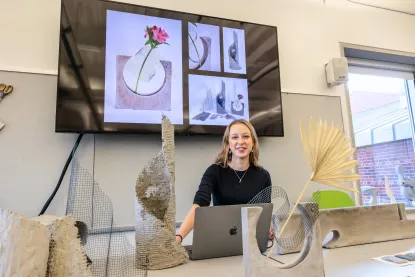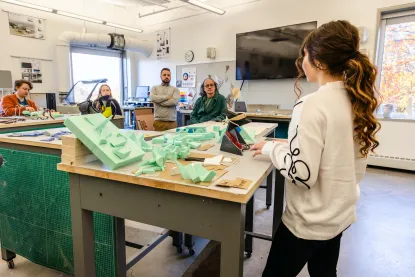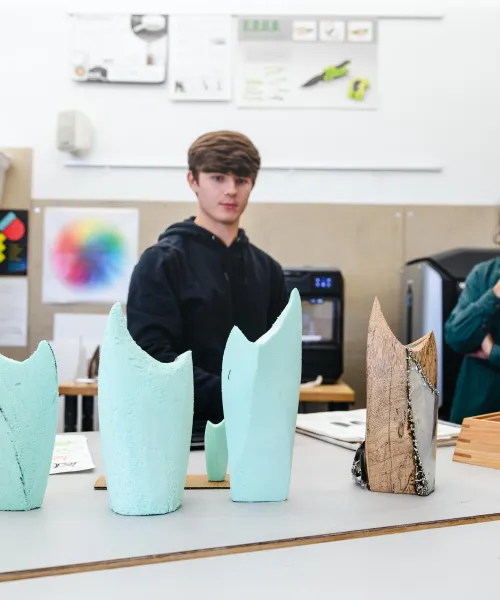Quick Links

About the Program
The Industrial Design program focuses on the conceptual development and realization of products, systems, and services. Students develop skills in sketching, problem solving, computer modeling, digital fabrication, and traditional crafting to create both physical products and speculative designs.
The curriculum emphasizes design thinking and research, with projects that explore user needs and encourage innovative solutions. Critiques provide feedback on concept, execution, and presentation. Industrial Design is ideal for students who enjoy cross-disciplinary, hands-on work that combines creativity, technical skill, and social impact.
Industrial Design Faculty
Industrial Design Courses
ARTD 209 Industrial Design: Foundations
4 credit hours
Offered: Fall, Winter
Studio format introduction into ideas becoming useful objects. Skill building in ideation, iteration, formgiving, and hands-on craftsmanship. Emphasis on playfulness, imagination, creativity, innovation, clear communication, and design awareness.
AD 311A Industrial Design: Virtual Modeling + Prototyping
4 credit hours
Offered: Fall, odd-numbered years
Prerequisite: Sophomore standing or instructor permission.
Intro to virtual modeling and product form sculpting, intertwined with digital fabrication and rapid prototyping. Skill building focuses on 3D printing, laser cutting, and CNC milling alongside hands-on clay shaping, model-making, NURBS, and vector graphics handling.
AD 311B Industrial Design: Body - Space and Comfort
4 credit hours
Offered: Fall, even-numbered years
Prerequisite: AD 101 or AD 209 or instructor permission.
Studio format exploration of body influence on product form and vice versa. Body mechanics and measurements are complemented with the study of behavior, rituals, needs, and desires. Sensory qualities of physical materials are explored with a focus on the visual and tactile.
AD 311C Craft Fusion
4 credit hours
Offered: Winter, even-numbered years
Prerequisite: Sophomore standing.
Studio format fusion of craft and industrial design, bridging human touch and serial production. Skill building in methodologies and hands-on techniques, ranging from traditional to experimental, with the aim of creating unique forms and practical objects that have potential for limited edition commercial release.
AD 411A Industrial Design: Forming Future
4 credit hours
Offered: Winter, odd-numbered years
Prerequisite: AD 303 or concurrent enrollment, AD 311A or AD 311B, or instructor’s permission.
Critical inquiry mixed with creative exploring, making, and discussing. Culminating in proposing and executing thoughtful, applicable, and sustainable design solutions. Focus on community, compassion, climate challenge, shared futur,e and AI integration. Client-side deliverables and presentation materials skill-building bridges to the post-graduation professional environment.

Industrial Design Studios
The two Industrial Design studios consist of spaces that allow for formal instruction, individual/collaborative work settings, and critiques. This space is designed to be flexible so that it can accommodate a variety of design activities and presentations. The fabrication studio provides a space for students to develop mock-ups and prototypes of their designs.
Within these two spaces, students have access to a range of model-making and rapid prototyping equipment for their use. Please be sure to look at the specific requirements for the major. Students are required to take courses in other studio areas as well as Industrial Design. Once the courses have been completed, students will have access to other facilities (Woodworking, Metals & Ceramics) with the professor’s permission.
Industrial Design FAQ
How do these courses prepare me as a designer?
The Industrial Design courses are rigorous, introducing and refining technical skills through both short- and long-term projects. Students also take additional courses in other studio areas, including Drawing, Graphic Design, Electronic Art & Animation, Metals, Ceramics, Woodworking, and Manufacturing Processes, to broaden their portfolio and enhance their design process, conceptual thinking, and presentation skills.
What degree should I pursue, and what is the difference between a Bachelor of Fine Arts (BFA) and a Bachelor of Arts (BA) or Bachelor of Science (BS)?
For careers in the design industry, a Bachelor of Fine Arts (BFA) is typically recommended. A BFA is also required for students who plan to pursue a Master of Fine Arts (MFA). The BFA offers more studio credit hours, with 40 credits in liberal studies and 46 credits in Art and Design, making it the most intensive option for hands-on training and professional preparation.
The Bachelor of Arts (BA) and Bachelor of Science (BS) provide more flexibility, allowing students to combine Industrial Design with a minor. Both degrees include 40 credits in liberal studies and 63 credits in Art and Design, with 34–44 open electives. The BA requires a language minor, while the BS allows minors in other areas outside the School of Art and Design. These options are ideal for students who want to diversify their skills and explore additional disciplines.
Does the school require a portfolio review before you are accepted into our programs?
If you are accepted to the university, you may pursue a degree within the School of Art & Design. While a portfolio is not required for entry, you may choose to present one to a professor in your studio area. Faculty can use this portfolio to determine whether you qualify for advanced placement credit (replaces both the course and credit hours), a waiver (replaces the course but not the credit hours), or to identify the appropriate studio level for you to begin. Portfolios may be reviewed during a campus visit or during a faculty member’s office hours during the semester.
Although there is no required portfolio review to enter the program, all Art & Design majors are required to complete a portfolio review with faculty (Individual Art Review, AD 303) during the twelfth week of each semester.
For information on general University admission requirements, contact the Admissions Office.
Are there scholarships available for incoming first-year students?
For information about scholarships for incoming freshmen, please visit the Scholarships & Financial Aid page.
